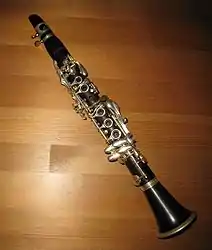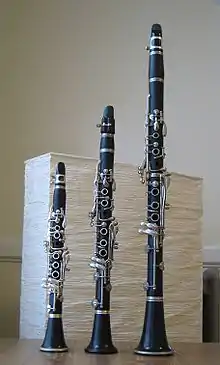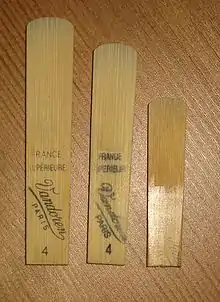A-flat clarinet
The A-flat (A♭) clarinet is a member of the clarinet family, smaller and sounding a perfect fourth higher than the E♭ clarinet. The A♭ is rare, but even less common, obsolete instruments in high C, B♭, and A♮ (an octave above the more common instruments in those keys) are listed by Shackleton. Some writers call the A♭ and these other instruments octave clarinets, sopranino clarinets, or piccolo clarinets. The boundary between the octave and soprano clarinets is not well-defined, and the rare instruments in G and F might be considered as either. Shackleton, along with many early twentieth-century composers, uses the term "piccolo clarinet" to refer to the E♭ and D clarinets as well (piccolo merely meaning "small" in Italian). This designation is less common today, with the E♭ and D instruments more usually designated soprano clarinets. The term "piccolo clarinet" is used by some recent music software (e.g., Finale) for the A♭ clarinet.
 A♭ clarinet | |
| Woodwind instrument | |
|---|---|
| Classification | Single-reed |
| Hornbostel–Sachs classification | 422.211.2-71 (Single-reeded aerophone with keys) |
| Related instruments | |
| Musicians | |
| Clarinetists | |
The A♭ clarinet is pitched a minor seventh higher than the B♭ clarinet. Its lowest note, E, sounds as concert middle C, the same as many concert flutes.
Clarinets pitched in A♭ appeared frequently in European wind bands, particularly in Spain and Italy, at least through the middle of the 20th century, and are called for in the stage-band parts for several operas by Verdi.[1]
Cecil Forsyth associated the high instruments with Austria saying, "Clarinets in (high) F, and even in (high) A♭ are occasionally used abroad. The latter instrument is regularly employed in the Austrian military bands."[2] A famous example of extensive use of a high clarinet in a Viennese small ensemble was the Schrammel quartet, consisting of two violins (the brothers Johann and Josef Schrammel), a bass guitar, and G clarinet, played by Georg Dänzer, during the 1880s.[1]

The A♭ clarinet is not uncommon in clarinet choir arrangements—for instance, those of Lucien Cailliet, including Mozart's Marriage of Figaro overture—though the instrument is often optional or cued in other voices. There are parts for A♭ clarinet in Béla Bartók's Scherzo for Piano and Orchestra, op. 2 ("mostly in unison with the E♭ or piccolo [flute]") and in John Tavener's Celtic Requiem (1969).[1] Several chamber works of Hans-Joachim Hespos employ the A♭ clarinet,[3] including the wild go which also features soprano sarrusophone, heckelphone, and tárogató. Hespos also uses the A♭ clarinet in the orchestral work Interactions.[4] Matthijs Vermeulen's Symphony Nr. 4 has a part for A♭ clarinet.[5]

At least three manufacturers currently produce A♭ clarinets: L. A. Ripamonti (featured in the pictures),[6] Orsi Instruments and Schwenk and Seggelke. Leblanc had produced A♭ clarinets prior to their acquisition by Conn-Selmer in 2004, but has since ceased production.[7] Ripamonti produces both German and French system (including Full Boehm) A♭ clarinets. Schwenk and Seggelke make German system clarinets in A♭ and high G.
Notes
- Basil Tschaikov, "The high clarinets," in Colin Lawson, The Cambridge companion to the clarinet, (Cambridge: Cambridge University Press, 1995), pp. 52-55.
- Forsyth, Orchestration, second edition, p. 281 (Dover Reprint) ISBN 978-0-486-24383-2
- "Hans-Joachim Hespos - Complete work (engl.) - Ensemble works". Hans-Joachim Hespos web site. Retrieved 2007-02-07.
- "Hans-Joachim Hespos - Complete work (engl.) - Orchestral works". Hans-Joachim Hespos web site. Retrieved 2007-02-07.
- "Symfonie nr4 - partituur netschrift". Matthijs Vermeulen. Archived from the original on July 30, 2018. Retrieved 29 July 2018.
- L. A. Ripamonti's A♭ clarinet page
- Post by Diz to the Clarinet List, 2003-06-27 based on information from Leblanc Sydney
References
- Nicholas Shackleton. "Clarinet", Grove Music Online, ed. L. Macy (accessed 21 February 2006), grovemusic.com (subscription access).